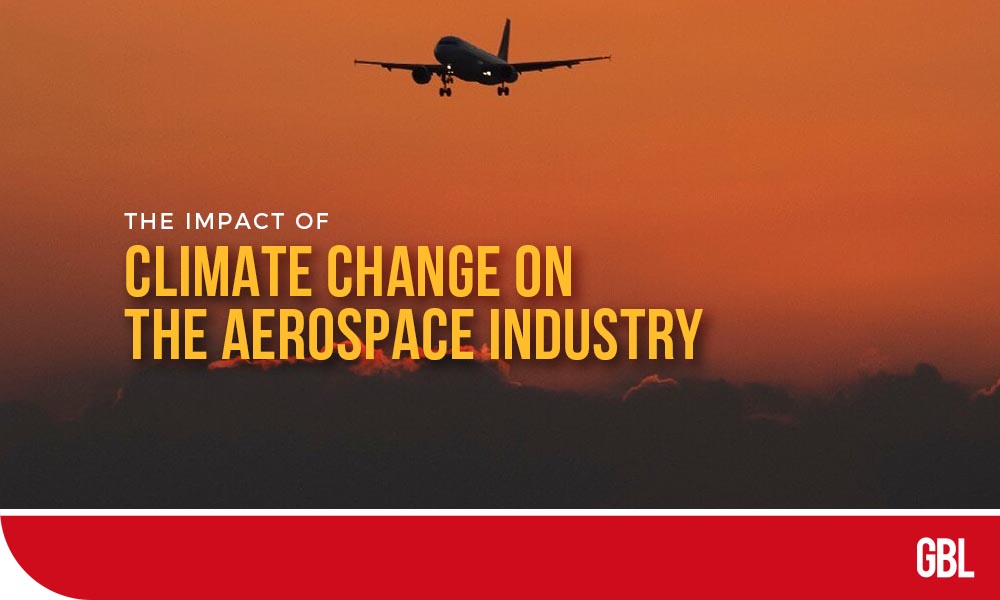The aerospace industry is making significant strides in decarbonization efforts, with ambitious strategies that are being implemented by airports, airlines, and states. The International Civil Aviation Organization (ICAO) aims to achieve net-zero carbon emissions by 2050. Climate change is one of the most pressing issues. It has a profound impact on the environment, economy, and society. The aviation industry is also one among them.
In 2022, the effects of climate change resulted in runways melting, storm damage causing flight delays and cancellations, and extreme precipitation leading to control towers flooding, temporarily closing airports. Heavy winter weather at the end of the year further impacted airport operations, causing even more delays and cancellations. We will explore the impact of climate change on the aerospace industry and the steps taken to mitigate its effects.
How Climate Change Is Affecting The Aerospace Industry
Climate change has several impacts on the aerospace industry.
1) Increasing Impact of Storms
The major challenge the aerospace industry faces is storms, which result in the following:
- Flight delays
- Rerouting
- Reduced horizontal flight efficiency.
These effects lead to increased fuel burn and CO2 emissions. Storms can cause damage to airport infrastructure, and climate change may exacerbate the issue by increasing the frequency of lightning strikes.
A study was conducted to gain insight into the potential future changes in the frequency and intensity of storms. The study findings suggest that by 2050, while the number of days with convective weather and major storms may increase in northern Europe, it may decrease in the south, resulting in an overall reduction. However, when major storms do occur, they will be more severe.
In terms of fuel consumption and CO2 emissions, over 1 million kilometers were flown in 2019 to avoid major storms, resulting in over 6,000 tons of extra fuel consumption or over 19,000 tons of CO2 emissions. While overall delays due to major storms may decrease, a delay caused by a major storm would be longer, averaging around 20-22 minutes per flight, compared to 17-18 minutes in 2019, with some variations in different regions.
2) Increase In Global Temperatures
One of the most significant impacts is the increase in global temperatures. This increase in temperature affects the performance of aircraft engines, which can lead to reduced efficiency and increased emissions. The rise in temperature also affects the air density, which can impact the takeoff and landing performance of aircraft.
Higher temperatures, both average and extreme, can significantly impact the aerospace industry’s operational performance. Warmer air is less dense, which requires more thrust during takeoff and may necessitate a longer runway or reduced payload during the hottest parts of the day.
Climate change may also affect tourism demand, as some locations may become too hot for tourists in the summer months, potentially leading to a shift in holiday seasons or destinations. This can affect the number of passengers and flights passing through airports and the necessary infrastructure and personnel. Although these changes are likely gradual, they should be considered in long-term airport planning.
3) Impacts of Sea-Level Rise
The potential consequences of sea-level rise on European airports were also investigated. The study examined 270 airports in the European Civil Aviation Conference (ECAC) region in low-lying coastal areas and discovered that more than two-thirds of them would be at risk of flooding from coastal or marine sources by the end of the century. This could have operational and economic implications.
If a large airport with over 100,000 annual movements were to shut down for an entire day due to flooding, it could impact about 2-3% of air traffic movements throughout the ECAC region, leading to delays, cancellations, and rerouting.
From an economic standpoint, such an event would cost roughly EUR 18 million for a large airport and about EUR 3 million for a medium-sized one. Furthermore, if one airport were to close, it would have a domino effect on the entire network.
4) Wind Pattern Changes
Wind pattern changes can have diverse impacts on aviation operations. Strong winds can lead to operation halts while prevailing wind direction changes can create issues for operations without a crosswind runway. High-altitude wind changes can affect flight times and challenge airport slot management.
Another study examined how changes to high-altitude winds could influence flight times. As mentioned below, the analysis included three route groups in both directions and for both summer and winter.
- Europe to North Asia
- Europe to North America
- North Europe to the Canary Islands
The research discovered that average flight times were reduced for all routes except for Europe to the Canaries route in winter.
Although the impact of wind pattern changes on a single flight may appear insignificant, the overall effect is far more significant. The overall reduction in flight times, resulting from stronger jet streams, is anticipated to bring savings of over 55,000 tonnes of aviation fuel per year, corresponding to approximately 175,000t of CO2 saved annually, with the most significant decrease expected on Asia routes.
Steps Taken By The Aerospace Industry To Mitigate The Impact of Climate Change
The aerospace industry is taking several steps to mitigate the impact of climate change.
1. Developing Fuel-Efficient Aircraft
One of the most significant steps is the development of more fuel-efficient aircraft. These aircraft are designed to use less fuel, which reduces emissions and saves airlines money. For example, the Boeing 787 Dreamliner and the Airbus A350 XWB use advanced materials and engines to reduce fuel consumption by up to 25%.
2. Developing Alternative Fuels
Another step taken by the aerospace industry is the development of alternative fuels. These fuels are made from renewable sources such as biofuels and hydrogen. They produce fewer emissions than traditional fossil fuels and can be used in existing aircraft engines with minimal modifications. For example, Virgin Atlantic flew a commercial flight from London to Amsterdam using a blend of biofuels and traditional jet fuel in 2018.
3. Develop Aircrafts Using Electric Motors and Batteries
The aerospace industry also explores new technologies such as electric and hybrid-electric aircraft. These aircraft use electric motors and batteries instead of traditional jet engines. They produce no emissions during flight and can revolutionize air travel. Several companies, including Airbus and Boeing, are investing in developing electric and hybrid-electric aircraft.
4. Use of Renewable Energy Sources
The aerospace industry is working to reduce the environmental impact of airports. This includes using renewable energy sources such as:
- Solar and wind power
- Installing energy-efficient lighting and heating systems
- Developing sustainable airport designs.
Conclusion
Climate change is a major challenge faced by the aerospace industry. However, the industry is taking significant steps to mitigate its impact. Additionally, the aviation industry is working to reduce airports’ environmental impact, which will positively impact the environment and the local communities. As we continue to address the challenges of climate change, it is understandable that the aerospace/ aviation industry has an important role in creating a more sustainable future.









